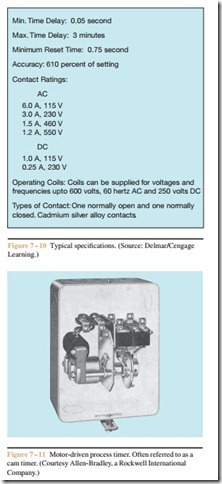Motor-Driven Timers
When a process has a definite on and off operation, or a sequence of successive operations, a motor-driven timer is generally used (Figure 7– 10 and Figure 7– 11). A typical application of a motor-driven timer is to con- trol laundry washers where the loaded motor is run for a given period in one direction, reversed, and then run in the opposite direction.
Generally, this type of timer consists of a small, synchronous motor driving a cam-dial assembly on a common shaft. A motor-driven timer successively closes and opens switch contacts, which are wired in circuits to energize control relays or contactors to achieve desired operations.
Related posts:
Synchronous Motor:Effect of Excitation on Armature Current and Power Factor
Basic troubleshooting principles:Testing devices
Introduction to Three-Phase Motor Types
Single-phase motors:Universal Motor
Two-layer Winding and Multiplex Winding
Transformer:Transformer with Winding Resistance but No Magnetic Leakage
Loudspeaker Enclosures:Loudspeakers
MAINTENANCE OF MOTORS:DIAGNOSTIC TESTING FOR MOTORS
PROGRAMMABLE-LOGIC AND APPLICATION-SPECIFIC INTEGRATED CIRCUITS (PLASIC):FABRICATION TECHNOLOGIES AN...
Work Habits and issues:Workplace Harassment
INDUCTION MACHINE TRANSIENTS
Lighting Circuits:Domestic Lighting Circuits
TRANSFORMERS:THE EQUIVALENT CIRCUIT OF A TRANSFORMER
Multiple-Delta Connection
